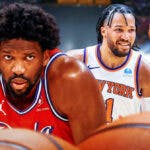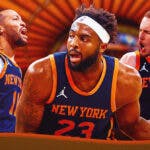Julius Randle is dawning the orange and blue and looking to show the NBA world why the New York Knicks gave him a three-year, $62.1 million deal. While he's already a skilled offensive player, sustaining a reliable jump shot would take Randle's game to the next level — and silence the critics.
Randle is coming off the best season of his NBA career. Averaging a career-high 21.4 points, as well as 8.7 rebounds and 3.1 assists per game while shooting a career-high 34.4 percent from beyond the arc, he made his presence felt in a multitude of ways for the New Orleans Pelicans. Sure, Anthony Davis requesting a midseason trade, which resulted in a decrease in playing time, played a part in Randle's increased role, but the Kentucky product also answered the call.
Randle is a multi-dimensional offensive player. He handles the rock, plays inside by means of operating in the post and finding a way to get inside off the dribble, is an underrated passer, and hits the boards at a plausible level. He has also developed a bit of an outside jump shot.
Is it one that defines his game? No, but it adds another dimension to his arsenal. In today's NBA, you rarely see a big man with the aforementioned qualities and an outside game performing at a high level — which Randle did last season. The million-dollar question is whether he can sustain the newfound element of his game.
It's important that Randle doesn't get too three-happy and make perimeter shooting the focal point of his game. Given how he's an at best inconsistent defender, Randle can't afford to become just an impressive shooter for his size; he needs to remain a well-rounded scorer.
Big men always get open looks. It usually comes down to them either getting rid of the rock to a guard or taking a jump shot. Randle usually does neither, as he'll put the ball on the floor and attack the rack. If he starts taking and hitting those jump shots with more consistency, he can keep his defender guessing, meaning he could pump fake his defender to get a clean lane. Or, he could get his defender leaning back, paving the way for a clean jump shot; it would make him unpredictable.
Look at Blake Griffin. After getting buckled by injuries, Griffin became more of a ball handler who attacked the rack but also hoisted up outside jump shots with ease. While Randle's career hasn't been along the same lines as Griffin from a health and fame standpoint, there's no reason why he can't adopt some of those philosophies to his game; it benefits both him and the Knicks.
At no point in his career has Randle's perimeter shooting defined his game, but last season and this preseason he has shown more of a willingness to hoist up outside jump shots. He's one of the few inside players at his size in the sport. If he continues to be an elusive threat who finishes and draws fouls inside while taking open shots, he could be unstoppable.
While the Knicks signed a lot of players to one-plus-one deals, Randle is the one player who's under contract for at least two years. As they look to build through RJ Barrett, Mitchell Robinson, Kevin Knox, Allonzo Trier, and others, the Knicks need to establish continuity.
You could argue that Randle is the Knicks' best player, and there's no reason why he can't be a part of that core. The Knicks likely didn't give him a hefty, multi-year deal without thinking he could improve and become a part of what they're building.
Plus, he could be a great fit with some of their youngsters. Randle and Robinson are polar opposites of each other. Randle is an inside player who struggles defensively. On the other hand, Robinson is an alley-oop threat and little more offensively and is a tenacious shot blocker. The two should complement each other nicely.
Meanwhile, Knox has shown a tendency to stand out on the perimeter and/or cut inside for layups, while Barrett is going to have the ball in his hands a lot. If Barrett gets double-teamed or is faced with a contested jumper, he can pass inside to Randle. And, if need be, Randle can bring the ball up the floor to take some pressure off Barrett and whoever head coach David Fizdale opts to start at point guard (Elfrid Payton, Dennis Smith Jr., or Frank Ntilikina).
Randle is 24. This is a player who broke his leg in his NBA debut, came back strong the next season, has improved his game from a skill set and production standpoint in each of the last four seasons, and earned a nice payday. It's a remarkable story, and he hasn't even entered his prime.
Randle's $62.1 million deal with the Knicks was the most undermined signing of the offseason. In the midst of missing out on Kevin Durant, Kyrie Irving, Kawhi Leonard, and other top-tier free agents, the Knicks have been relentlessly teased, as many thought they were in store for a franchise-altering offseason.
Instead, they signed Randle, Payton, Taj Gibson, Bobby Portis, Reggie Bullock, Wayne Ellington, and Marcus Morris. Randle's contract was the biggest of the seven and ridiculed the most, as some say he was overpaid. But, let's be real: if the Philadelphia 76ers, Brooklyn Nets, or another team in good graces with the public eye signed Randle, would people be spewing the same narrative?
It's a three-point shooting league. Randle could easily have success being an interior player with the Knicks over the next two-to-three years. But he could also be 80 percent of that player while taking open looks from beyond the arc, giving the Knicks some much-needed outside shooting.
If you were told that there was a 6-foot-9 forward who could shoot, play in the post, draw fouls, handle the rock, and hit the boards, wouldn't you guess that he was a star player?
Randle has the offensive skill set to be elite. Adding a permanent outside game to the equation gives him the chance to make that jump.




